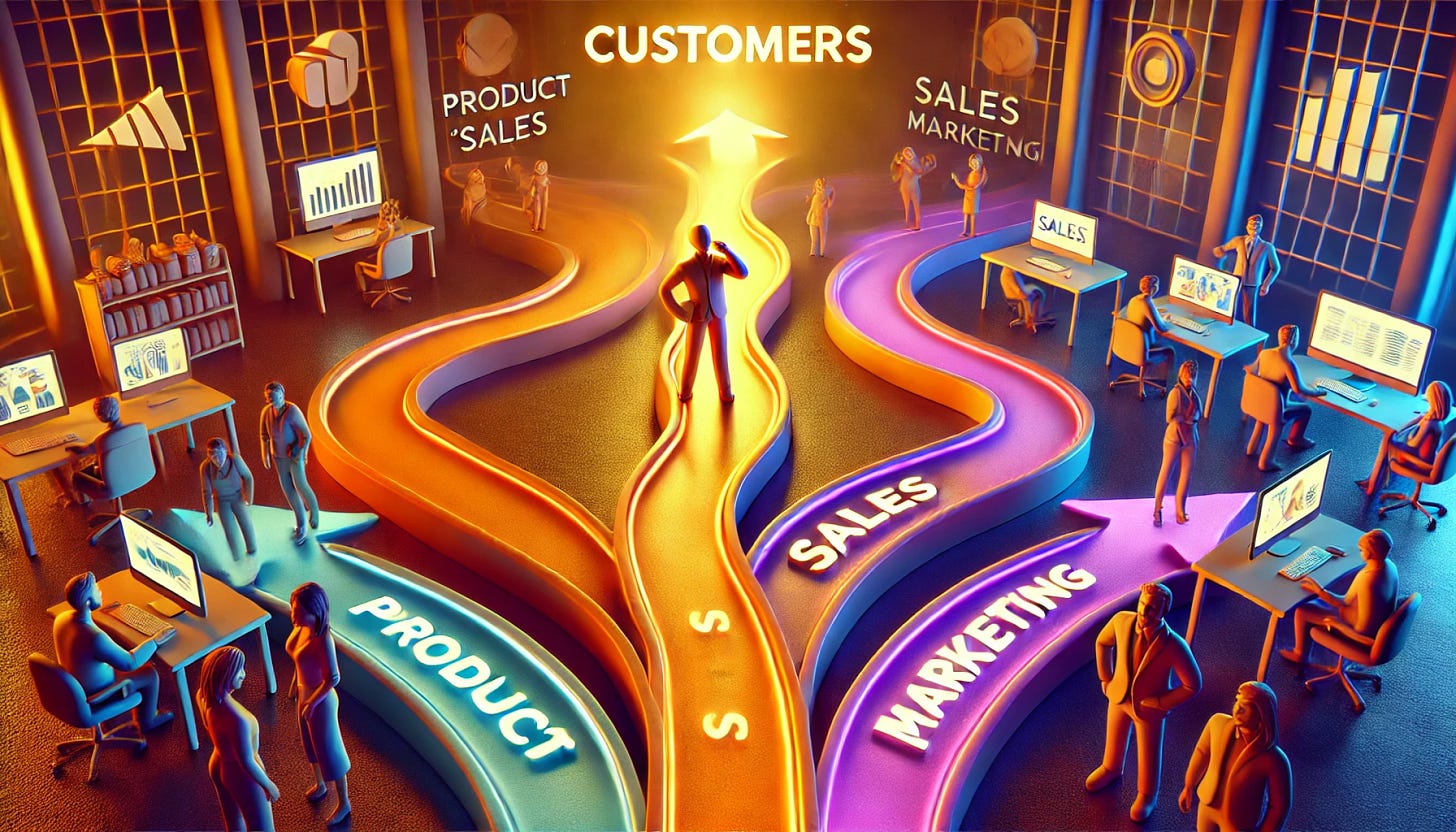Why Startups Should Be Customer-Obsessed, Not Product or Sales-Obsessed
Stop Worshiping Your Product—Your Customers Don’t Care (Yet!)
Most startups fall into one of three traps: they become product-focused, sales-focused, or marketing-focused. Each of these approaches has its strengths, but they miss the real key to sustainable growth—being customer-obsessed. Not customer-aware. Not customer-driven. But truly customer-obsessed, where every decision, iteration, and strategy revolves around the people who bring in revenue or attract more users.
But that leads to an important question: which customers should you focus on? With different user personas, demographics, and behavioral patterns emerging in your app or product, where do you place your attention? This is where revenue and referrals become the guiding factors for prioritization.
Let’s break down why customer obsession is the only strategy that truly works and how to use revenue and referrals as the two key focus areas.
Why Product, Sales, and Marketing Alone Won’t Drive Sustainable Growth
Many startups struggle with growth because they focus too much on one specific area:
1. The Product-Obsessed Startup
Some companies believe that if the product is great, everything else will follow. But history has shown that even the best products can fail if they don’t align with user behavior, needs, and expectations.
A strong product is essential, but it’s not the product itself that matters most—it’s the experience it delivers. A product without an intuitive onboarding process or a clear pathway to value will see low engagement and high churn. Users don’t just adopt features; they adopt the value those features provide.
For example, optimizing activation flows, improving onboarding, and using behavioral nudges to guide users to meaningful actions can significantly increase retention and free-to-paid conversion rates. Users need to experience value, not just be given access to features.
2. The Sales-Obsessed Startup
Many startups take a sales-first approach, believing that hiring more sales reps will drive growth. However, modern buyers—especially in B2B SaaS—expect to try before they buy. They want to explore a product, validate its value, and onboard themselves before engaging with sales.
A hybrid approach is far more effective: enabling self-serve experiences while ensuring sales teams are ready to assist when necessary. This balances automation with human interaction, allowing high-value users to convert on their own while sales focuses on larger, more complex deals.
3. The Marketing-Obsessed Startup
Marketing plays a crucial role in growth, but it’s ineffective when done in isolation. Too many startups pour resources into brand awareness, virality, or performance marketing without ensuring a seamless customer journey. If users sign up but don’t experience immediate value, they churn before becoming paying customers.
A more effective approach is to ensure that marketing efforts are tightly integrated with user experience, product engagement, and retention strategies. Instead of just driving signups, marketing should focus on ensuring new users actually experience the product’s value—whether through personalized onboarding sequences, educational content, or community engagement.
The Two Types of Customers Startups Should Focus On
Startups often spread their focus too thin across all types of users. Instead, the most successful companies prioritize two specific types of customers:
1. Customers Who Generate Revenue
The most valuable users are not just those who love the product but those who are paying customers. Monetization should be designed around these users’ behaviors, ensuring their journey from free to paid is smooth and natural.
A well-optimized free-to-paid conversion rate is a strong indicator of business health. Benchmarks suggest that a 3%-5% free-to-paid conversion rate is good for self-serve PLG products, while 6%-8% is considered excellent. Companies that implement dynamic, behavior-driven onboarding and contextual upgrade prompts often see significantly higher conversion rates.
Rather than trying to upsell every user, focusing on the behaviors of high-value users—those who reach key milestones or show strong engagement—creates a natural and effective monetization path.
2. Customers Who Bring More Customers
Word-of-mouth and referrals are often underutilized in B2B SaaS but are among the most powerful growth drivers. The best SaaS companies achieve a 1:5 ratio, meaning that for every five users, one new paying customer is referred.
Referred users tend to:
Convert 4x better than users acquired through paid ads
Stay longer and have higher lifetime value
Advocate for the product, creating a compounding effect
A well-structured referral system should be seamlessly integrated into the product experience. Incentives must be meaningful—whether monetary rewards, extended free trials, or exclusive access to premium features. More importantly, referrals should feel effortless for the user.
The most effective referral strategies:
Place referral prompts at the right moment (e.g., after a user achieves a milestone)
Offer multi-sided incentives (both the referrer and the new user get a benefit)
Make sharing frictionless with one-click referral links
Optimize for Customer Experience Over Product Features
Startups often focus too much on adding more features, believing that more functionality will attract and retain users. However, it’s the experience those features enable that truly matters.
1. Simplify Onboarding
A frictionless onboarding experience directly impacts activation and retention. Reducing the number of initial steps, personalizing the onboarding flow based on user behavior, and offering real-time guidance significantly improve conversion rates.
For example, when onboarding flows guide users to a meaningful first action—rather than leaving them to figure it out alone—engagement rates increase. Instead of overloading users with options, focusing on leading them to a single “aha” moment ensures they quickly experience the product’s core value.
2. Personalize the User Journey
Personalization is key to retention. Rather than a one-size-fits-all experience, dynamic user journeys based on real product interactions ensure that users receive relevant prompts, support, and content.
For example, when users take specific actions—such as completing an onboarding milestone—triggered messages that guide them to the next step significantly increase engagement. Instead of sending generic emails, customizing outreach based on what users have (or haven’t) done in the product creates a far more effective growth loop.
3. Optimize Monetization Around the Right Users
A thoughtful monetization strategy ensures that pricing, packaging, and upgrade flows align with real user behavior. Instead of aggressively pushing upgrades, the focus should be on guiding users toward paid features at the moment they naturally need them.
Smart monetization strategies include:
Using subtle upgrade prompts when users engage with premium features
Offering time-limited access to premium features before requiring payment
Providing flexible pricing tiers that match user needs
Building a successful startup means being customer-obsessed.
Prioritize the right users – Focus on those who generate revenue and those who bring in more users.
Optimize for experience, not just features – Ensure that users feel the value of the product rather than just interact with it.
Leverage behavior-driven strategies – Guide users naturally to conversion through personalized onboarding, seamless referrals, and frictionless monetization.
The startups that scale successfully are those that obsess over their customers’ experience, not just their product or marketing. The shift from selling a product to delivering an experience is what drives long-term growth.






